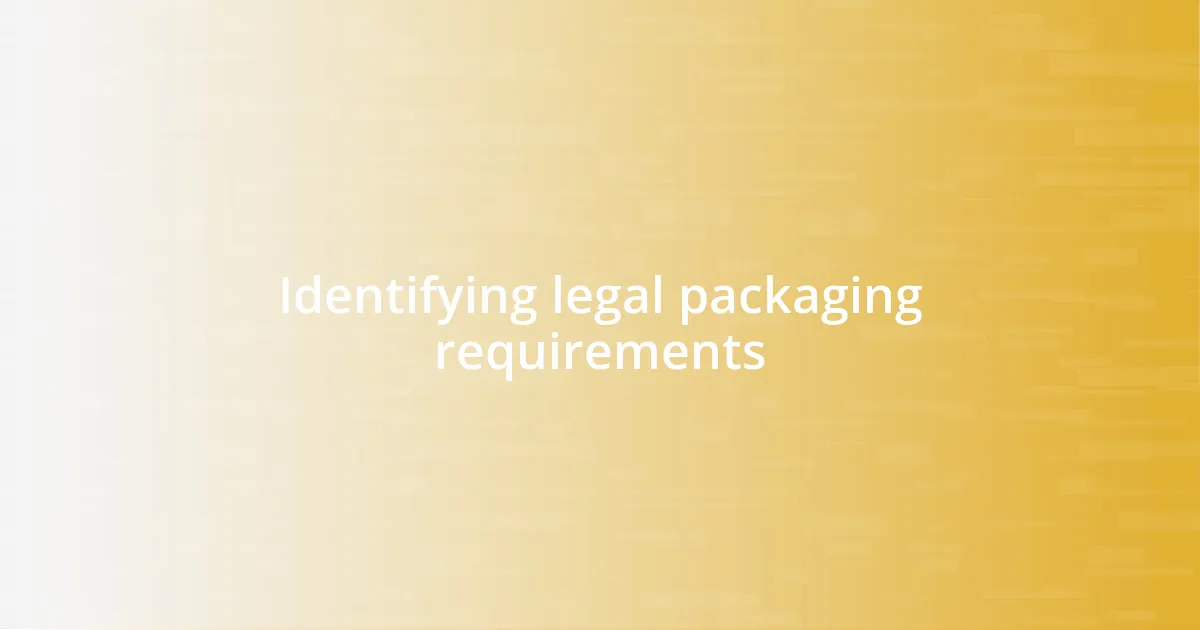Key takeaways:
- Compliance with legal packaging requirements, such as child-resistant features and clear labeling, is essential for building consumer trust and safety.
- Choosing the right packaging materials, including biodegradable options, can enhance product integrity and attract eco-conscious customers.
- Designing attractive and informative packaging not only meets regulations but also fosters a positive consumer experience and brand loyalty.
- Sustainable practices in packaging resonate with consumers and can elevate brand perception while demonstrating a commitment to environmental responsibility.

Understanding CBD packaging basics
Understanding CBD packaging basics is essential for any brand entering this growing market. From my experience, I’ve seen how the right packaging can set a product apart. Picture this: the moment a customer picks up your product, what they see shapes their first impression—are they drawn in or pushed away?
When it comes to CBD packaging, adherence to regulations is non-negotiable. I remember sifting through endless guidelines, feeling overwhelmed. But I realized that compliance not only protects the consumer but also builds trust in your brand. Have you ever thought about how transparency and clarity on labels can directly impact customer loyalty?
Another fundamental aspect is choosing the right materials. I’ve learned firsthand that the type of container can affect both product quality and consumer perception. For instance, I once opted for glass packaging for a CBD oil, believing it conveyed a premium feel. That choice ultimately resonated with my customers, enhancing their overall experience. What insights have you gathered about packaging materials in your journey?

Identifying legal packaging requirements
Identifying legal packaging requirements for CBD products can initially seem daunting, but it’s a crucial step. In my early days in this industry, I found myself knee-deep in state and federal regulations. It’s not just about aesthetics; it’s about ensuring that every label meets legal specifications to avoid penalties and maintain trust. The process can feel like navigating a maze, but every twist and turn ultimately leads to better compliance.
I distinctly remember the day I discovered the importance of child-resistant packaging for my CBD edibles. I thought, “How could something so small have such a significant impact?” It turned out that not only was it a requirement, but customers appreciated the extra step towards safety. I even received a heartfelt message from a parent thanking me for taking their child’s safety seriously. This experience taught me that adherence to regulations is intertwined with care for our customers.
When I evaluated the labeling requirements, I realized that they go beyond just ingredient listing. Clear dosage information and health disclaimers are paramount. Initially, I thought I could keep it simple, but I soon learned that clarity aids informed choices. Legal packaging specifications are not just boxes to check—they create a framework for building a trustworthy relationship with consumers.
| Regulation Aspect | Details |
|---|---|
| Federal Regulations | Must comply with FDA guidelines on food labeling and claims. |
| Child-Resistant Packaging | Required for edibles to prevent accidental consumption by children. |

Choosing the right materials
Choosing the right materials for CBD packaging is crucial for maintaining product integrity and enhancing consumer trust. I had a moment during my packaging journey that truly highlighted this. I switched from plastic to biodegradable materials for my product line, and the positive feedback was immediate. Customers loved knowing they were making an eco-friendly choice alongside using my CBD products. This experience taught me that the materials you choose can resonate with your audience, sometimes creating a connection that goes beyond the product itself.
Here’s a quick overview of considerations I keep in mind when selecting materials:
- Durability: Ensure that the materials withstand environmental factors, preserving product potency.
- Safety: Use FDA-compliant materials, making certain they don’t leach harmful substances into the product.
- Aesthetic Appeal: The packaging should be visually appealing, reflecting the brand’s identity and quality.
- Environmental Impact: Opt for sustainable materials like glass or biodegradable options to attract eco-conscious consumers.
- Functionality: Choose materials that enhance usability, like easy-pour spouts or resealable pouches, to improve customer experience.
Every material choice is a step toward building a brand that speaks to quality and care. It’s not just about what holds the product—it’s about creating an experience that makes consumers feel valued and connected.

Designing compliant packaging
Designing compliant packaging requires striking a balance between creativity and regulation. I’ll never forget the moment I realized that the design of my packaging could actually influence how customers perceive compliance. I opted for a bold, clear label that didn’t just meet the legal requirements but also communicated the brand’s ethos. It felt great to showcase an attractive design while adhering to the strict guidelines. This move reminded me that functional packaging can also be eye-catching, fostering a connection with consumers right at first glance.
As I worked through the design process, I was constantly asking myself: Are we genuinely portraying our commitment to safety? This question guided my design choices, from incorporating warning symbols to ensuring that the required information, like ingredient lists and dosage instructions, were prominently displayed. I believe that transparency is vital in this industry. For instance, I once redesigned a label after realizing some essential information was buried in small print. The more visible information not only helped with compliance but also built consumer confidence.
Another aspect I often reflect on is the power of texture in packaging design. I experimented with soft-touch finishes, which conveyed a premium feel and made customers more inclined to reach for the product. This kind of tactile experience can elevate perception while ensuring we meet essential regulations. It’s incredible how design elements can align with compliance and enhance user interaction, proving that thoughtful packaging can engage customers on multiple levels.

Incorporating child-resistant features
Incorporating child-resistant features into my packaging was a challenge that I took on with great seriousness. I remember vividly the day I received feedback from a concerned parent, who shared how they worried about their curious toddler and my products. It struck a chord with me. I understood then that implementing child-resistant mechanisms wasn’t just a regulatory requirement; it was about protecting families and ensuring peace of mind for my consumers.
To tackle this, I considered various designs, ultimately opting for push-and-turn caps that required a little dexterity to open. But what truly amazed me was how excited some customers were about this feature! In conversations, they expressed gratitude for the added safety, which reinforced my belief that thoughtful design can deepen customer loyalty. I often wonder: how can we, as brands, further support consumers in providing safe environments for their loved ones?
During testing, I invited some friends over to try out the new packaging. It was humorous to watch them fumble with the child-resistant features, but it highlighted an important point: safety features should not compromise user-friendliness. Striking that balance is crucial. This hands-on experimentation not only validated my design choices but also fostered a sense of community. In the end, I found that being able to safeguard children while still making the packaging engaging is a win-win that resonates deeply with customers.

Labeling regulations for CBD products
Labeling regulations for CBD products are a crucial component of ensuring consumer safety and product transparency. I’ve learned firsthand how specific information must appear on the label—like the CBD content, a full ingredient list, and any potential allergens. I can still recall the moment I discovered that omitting even one detail could lead to serious compliance issues. It felt overwhelming, but it also ignited my determination to create labels that were both informative and attractive.
One regulation that often catches people off guard is the requirement for a clear statement about the product’s source. I vividly remember an instance when I had to reprint thousands of labels because I initially forgot to indicate whether the CBD was derived from hemp or marijuana. The frustration was palpable, but it taught me the importance of fully understanding labeling requirements. Now, I always double-check and emphasize this info—it builds trust with consumers, and I genuinely believe it adds to the overall quality of our brand.
Moreover, there’s an emotional aspect to labeling that I never expected. When consumers see clear warnings about potential side effects or advice not to operate heavy machinery, it felt like a responsibility I had to embrace. It’s more than just fulfilling legal obligations; it’s about protecting someone who might be trying CBD for the first time. Reflecting on this, I can’t help but wonder: how can we further educate consumers through our labels? I strive to create a labeling experience that not only complies but also fosters an informed community, helping consumers feel confident about their choices.

Sustainable practices in CBD packaging
Sustainable practices in CBD packaging have become essential not just for compliance but for fostering a deeper connection with eco-conscious consumers. I’ve often found myself reflecting on how every piece of packaging I select should align with my values. For instance, I switched to biodegradable materials for my boxes after learning about the shocking amount of plastic waste generated in our industry. That decision was as much about my responsibility to the planet as it was about appealing to customers who care about sustainability. Have you ever considered the long-term impact of packaging choices on our environment?
I can still vividly remember the moment I unveiled my new packaging design at a local market. Customers were genuinely excited to hear that the materials were not only recyclable but also made from post-consumer waste. Their enthusiasm made me realize that transparency in sourcing and production speaks volumes. This rejuvenated my passion for creating products that aren’t just good for the user but also kind to the Earth. I often wonder how we might inspire other brands to follow suit and elevate industry standards.
Incorporating sustainable practices doesn’t always have to mean sacrificing aesthetics. I’ve had numerous conversations with customers about how minimalistic packaging using earthy tones and plant-based inks can convey a brand’s commitment to the environment. I once experimented with a sleek, all-paper design that not only caught the eye but also sparked dialogues about sustainability at every consumer touchpoint. It’s clear to me now that sustainability can be beautiful—it’s about time we made that our hallmark. How might you perceive a product differently if you knew its packaging was crafted with the planet in mind?















